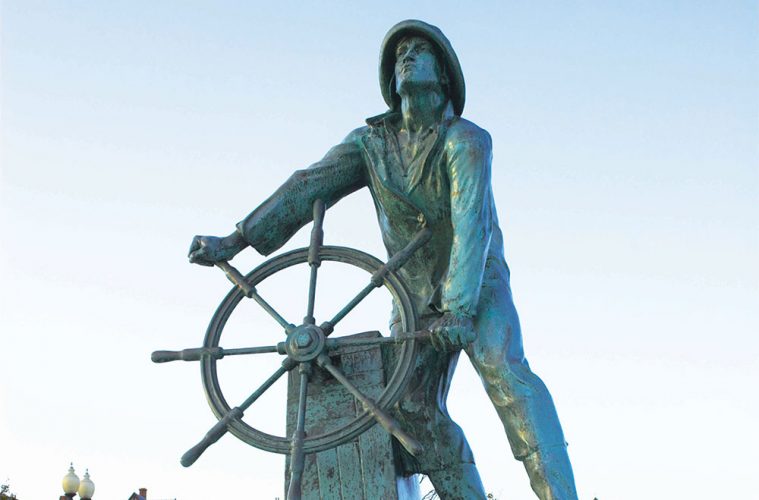Was it the granite that brought the sculptors to Cape Ann? Or was it the light? In the case of Charles Grafly, it was the fresh air. A teacher at the Pennsylvania Academy of the Fine Arts, he established a summer home near Folly Cove in 1902 because his daughter suffered from respiratory problems; her doctor recommended that she breathe air cleaner than her native Philadelphia’s.
The breezes blowing across the rocky, wooded landscape from Ipswich Bay were pure and invigorating, and the views were inspiring. Additionally, the landscape was bathed in the incomparable light that only exists in places surrounded by water. It had drawn artists to Cape Ann since the beginning of the 19th century, and once they came to visit, they tended to return.
Grafly not only returned every summer, but he also brought several of his students. George Demetrios, Walker Hancock, and Katharine Lane Weems were all famous sculptors long associated with Cape Ann who came here to study with their teacher.
But it was a couple of women who first suggested the area to Grafly. Ellen Day Hale and Gabrielle de Veaux Clements were artists and lifelong partners who lived on Cape Ann in a house they called “The Thickets.” When Grafly talked about his daughter’s breathing problems, they steered him to their adopted home.
Even before Hale and Clements, this part of Cape Ann was home to Anna Hyatt Huntington. Born in 1876, she had a thriving career at a time when very few women worked as artists, fewer still achieving any success. Huntington’s family started spending time in Annisquam when she was two years old. Her father, Alpheus Hyatt, a professor of paleontology and zoology at Harvard University and MIT, served as director of what is now Boston’s Museum of Science and helped establish the Woods Hole Marine Biological Laboratory. His daughter inherited his fascination with animals and became famous for her animal sculptures, which combine vivid emotional depth with skillful realism. Her Joan of Arc, created in 1915, is an important fixture on Cape Ann; other castings of the monumental equestrian statue stand in Blois, France; San Francisco; and Québec City. The one at the intersection of Riverside Drive and 93rd Street in Manhattan was the city’s first monument dedicated to a historical woman, instead of an idealized female figure such as peace or victory.
Besides Joan of Arc, Gloucester has other important pieces of public sculpture, including Leonard Craske’s 1925 Man at the Wheel, or also known as the Fisherman’s Memorial, and the 2001 Gloucester Fishermen’s Wives Memorial. Both are located on Stacy Boulevard, where they gaze out at Gloucester Harbor and the sea beyond.
In 1923, when she was 47 years old, Anna Hyatt married Archer Huntington, one of the richest men in the country. After that, she never returned to Cape Ann. By then, the community of sculptors in Lanesville was well established.
A hit-and-run driver struck Grafly in 1929; on his deathbed, he asked Walker Hancock to succeed him as instructor of sculpture at the Pennsylvania Academy of the Fine Arts. Hancock located established his home and studio at the edge of an abandoned granite quarry in Lanesville and worked there until his death in 1998. He served in the U.S. Army during World War II and became one of the “Monuments Men” who recovered art looted by the Nazis. His most famous sculpture is the Pennsylvania Railroad World War II Memorial, a 39-foot bronze sculpture entitled Angel of the Resurrection. It depicts the archangel Michael lifting a fallen soldier from the flames of war. Hancock said it was his favorite sculpture.
Paul Manship was already famous when he decided that he, too, wanted to establish his studio at a quarry. He had first come to Lanesville in 1915, accompanying his friend Maxfield Parrish. Manship’s clean, streamlined style became a favorite of an early-20th-century public that was weary of Beaux Arts classical realism but not ready for the radical and abstract art trends of the time. Today, we associate Manship’s sculpture with essential Art Deco styling. His most famous work is a fountain in the center of New York’s Rockefeller Center, Prometheus Bringing Fire from Heaven, completed in 1934. Although many Americans today don’t know who Manship was, most of them know the famous Prometheus statue.
In 1944, Manship bought 15-plus acres of land in Lanesville that included two quarries. Because it was wartime, building materials were unavailable, so the artist moved to a circa 1865 house and an 1856 ox barn adjacent to the property. His summer home and studio became a center for the social life of Lanesville sculptors, including Macedonia-born Demetrios. His wife, Virginia Lee Burton, wrote and illustrated children’s books and was a founder of the Folly Cove Designers, a printmaking guild that achieved national fame. When the Demetrios’s nearby home burned in 1947, the family moved to the Manships’ house until their own was rebuilt.
Although most all of these artists are gone, their art lives in museums, public squares, and private collections around the world. And while all the other artists’ studios have passed into other hands to become private homes, Manship’s home and studio are still intact. Occupied by his son and daughter-in-law, also artists, until recently, the beautiful estate overlooking two quarries will see new life as the nonprofit Manship Artist Residence and Studios. Once the center of Lanesville’s extraordinary art colony, it promises to continue to bring artists to this rocky, wooded area washed by clean ocean breezes and bathed in shimmering, watery light.

